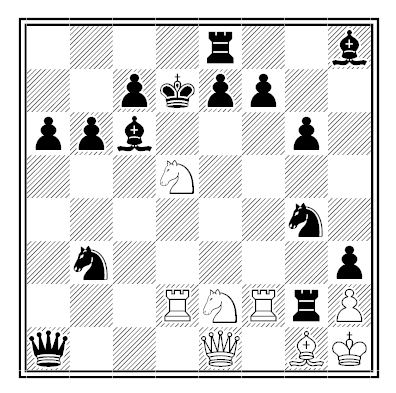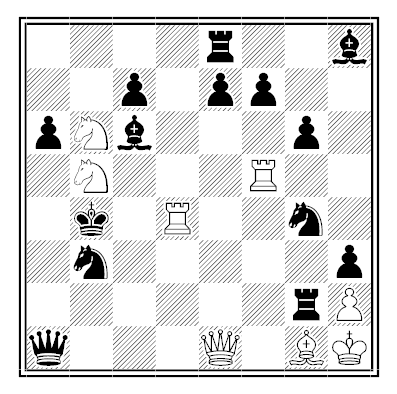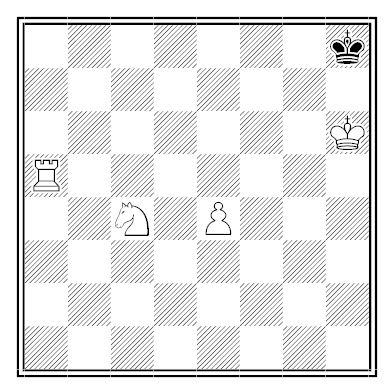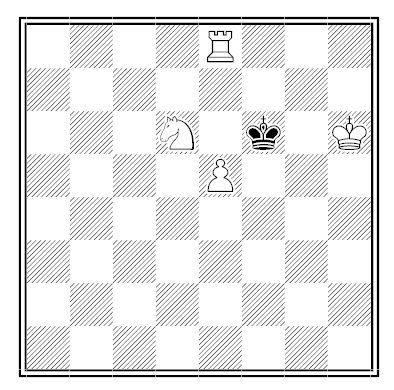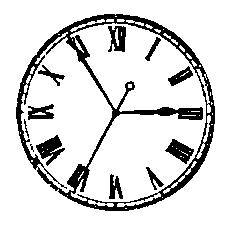
In 1905, the Ingersoll company engaged Sam Loyd to invent a puzzle to promote its new dollar watch. Loyd sent the illustration above and asked:
How soon will the hour, minute and second hands again appear equal distances apart?
The company advertised the puzzle in Scribner’s in June, promising a free watch to the first 10,000 correct respondents. “The full problem is stated above,” the ad ran, “and no further information can be given in fairness to all contestants.” Further, it said, Loyd’s solution “is locked in our safe, inaccessible to any one.”
Perhaps it still is — I can’t find any record of a solution to the puzzle. I offer it here for what it’s worth.
06/02/2024 UPDATE: Reader Alexander Rodgers writes:
I had to give it a go. To summarise my findings:
- It isn’t actually possible for the three hands of a clock to be perfectly equally spaced apart, barring some unusual hand-moving mechanisms. Even the time shown in the picture isn’t perfectly equal.
- The answer therefore probably hinges on the phrase “appear equal”.
- That’s subjective, so I present three answers, and one can pick which is the earliest time that “appears” equal:
- 0h 43m 23s later, at 3:37:58
- 2h 54m 34s later, at 5:49:09
- 6h 10m 50s later, at 9:05:25.
The company may claim the puzzle is present in full. But on attempting it, I found it difficult to determine what assumptions the puzzle is working under.
I started by assuming two things:
- That “equal distances apart” means each pair of hands forms an angle of exactly 120 degrees.
- That the hands move continuously, rather than ‘ticking’ in some way.
Under these assumptions though, the example time pictured isn’t actually at equal distances.
The time pictured is about 2:55:35. I found the exact time at which the second and minute hands are exactly 120º: it is 2:55.34.576… (Specifically, it is (171+2/3)/59 hours after twelve.) At this time:
The hour hand has moved (2 + 54/60 + 34.576/3600)/12 revolutions or 87.29º;
The minute hand has moved 2 full revolutions, plus another (54/60 + 34.576/3600) or 327.46º;
The second hand has moved many revolutions plus 34.576/60 or 207.46º.
So the three angles are 120º exactly, 120.17º, and 119.83º. Any times close to this time might get another pair bang on but the second/minute pair will be off.
In fact, I have determined that under my two assumptions there are no points in time at all where the hands truly are equal distances apart.
Proof:
Measure time (t) in “hours past twelve”. Then the number of revolutions of each hand at time t is:
S(t) = 60t for the second hand,
M(t) = t for the minute hand, and
H(t) = (1/12)t for the hour hand.
We can take the difference in any two of these functions. If the result is a whole number plus 1/3, then the angle between them is 1/3 of a full circle or 120º. If the result is a whole number plus 2/3, then the angle between them is also 120º. But if it’s anything else, then the angle isn’t 120º.
So, say for the hour/minute pair, the angle is 120º if and only if:
(M(t) – H(t))t = k +1/3 OR (M(t) – H(t))t = k +2/3, where k is an integer
We can rearrange these as:
t = (k +1/3)/(11/12) OR t = (k +2/3)/(11/12)
We can then just plug in all integers and output a list of valid times t. (We don’t need to do all integers, since t really is a number of at least 0 and less than 12. We start with k=0, and increase it until the resulting t is greater than 12.)
This generates a list of 22 times in a full cycle when the hour and minute hand are exactly 120º apart.
We can do the same with the minute and second hands. We get a list of 1417 times when they are exactly 120º apart. We then compare our two lists looking for times when both of these pairs are 120º apart.
But no values appear in both lists. Therefore there is no time then the hands are truly “equal distances apart”.
So to find an answer to this puzzle, we need to remove at least one of our two assumptions. I first tried removing the “exactly 120º” assumption, and instead went hunting for times when the hands would look equally spaced apart to the naked eye. After all, the puzzle did say “appear equal distances apart”.
For any two pairs of hands, I made a function that is zero if the angle is exactly 120º, and a positive number if not, specifically being a larger number the further we get from 120º. For, say, the minute/hour pair, the function is:

(where |x| is absolute value of x and {x} is the fractional part of x)
This function works as follows: Take the difference in total revolutions at time t. Discard the integer component and just keep the fractional part. For the angle to be 120º, then this figure is either 1/3 or 2/3; either way it is “1/6 away from 1/2, though in either direction”. The function gives zero when the angle is exactly 120º, and increases as the angle drifts from this goal up to a maximum output of 1/3.
I defined “distance off perfect” as being the largest of the three of these functions.
For every time between zero and twelve, we can find the worst result of this function for the three pairs. This gives the following graph:

I zoom in the y-axis so we can see how close those spikes get to zero:
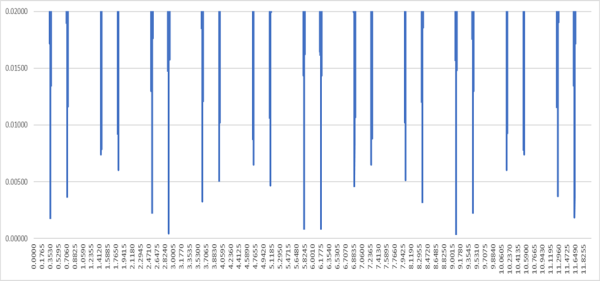
I can then read points off the graph that are close to zero, and those will be close to ‘equal distance’.
The next times of day after 2:55:35 that might look good are:
- 3 hours, 37 minutes, 58.15 seconds after midnight. Positions are 348.91º, 227.82º, 108.98º; angles are 118.83º, 121.10º, and 120.07º. (So decent, but not within 1 degree.)
- 5 hours, 49 minutes, 9.16 seconds after midnight. Positions are 54.94º, 294.92º, 174.58º; angles are 119.64º, 120.34º, and 120.02º.
- 9 hours, 5 minutes, 25.45 seconds after midnight. Positions are 152.54º, 32.54º, 272.71º; angles are 120º exactly, 120.17º, and 119.83º.
The last position gives exactly the same angles as the example image in the puzzle. This is because it is exactly the same amount of time before twelve as the example in the question is after 12, and this produces a mirror image.
I don’t have as much to say about removing the assumption about the hand moving continuously, as I don’t know enough about how clocks work to give a full answer. But I think it doesn’t help us find a perfect moment of equal distances. My understanding of a ticking clock mechanism is that it will jump forward every second but it will never produce a position that was unseen from those in the continuous model. You’d need some sort of clock where each hand is jumping on a different mechanism?
Overall, if I was submitting an answer to the competition, I’d submit 5:49:09. If the organisers noted the hands weren’t perfectly equal distances apart, I’d rebut that neither were they in their own example.
(Thanks, Alex. I wonder now whether Loyd had in mind some “trick” solution such as noon or midnight.)






